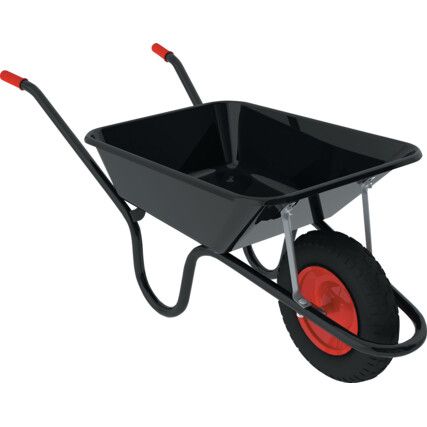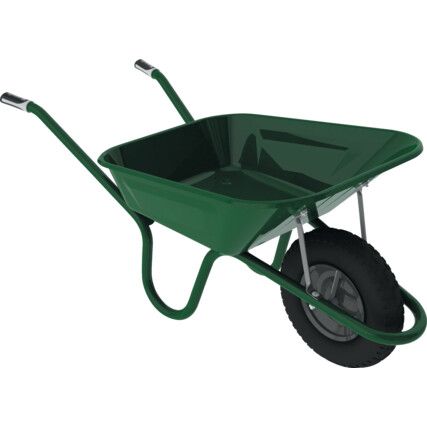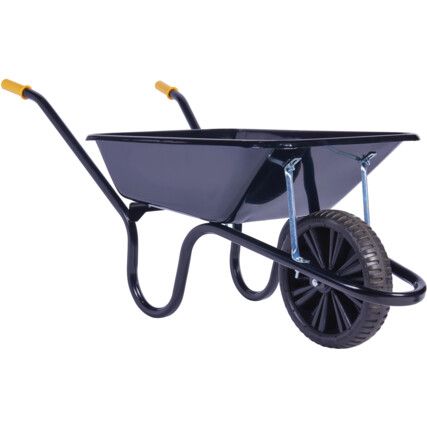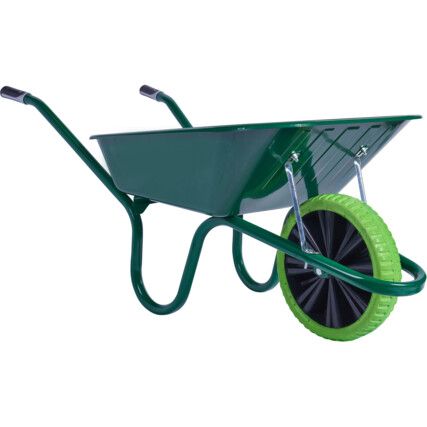Wheelbarrows
Discover our selection of high-quality wheelbarrows online at Cromwell. We carefully choose our products based on performance and value for money to give our customers the best buying experience. Choose wheelbarrows in a range of materials and tyre types from our most trusted brand, Haemmerlin®.
What are wheelbarrows?
A wheelbarrow features a metal framework with one or two wheels and a plastic or metal tray with a sloped end. They have long handles suitable for pushing, lifting and tilting the barrow to tip the contents out, and are used to carry a range of materials, including soil, bricks and hardcore, cement, and more.
Why buy wheelbarrows?
Wheelbarrows are a practical hand tool which allow users to easily move materials from one location to another. Made in either plastic or metal, they're ideal for a wide range of jobs.
When are wheelbarrows used?
A staple in construction and bricklaying, wheelbarrows are often used to transport old bricks from the site to a skip, or transport cement from the mixer to the wall. Wheelbarrows are also a mainstay in landscape and domestic gardening and are used to move large amounts of soil or plants to their final location.
Wheelbarrow types
Wheelbarrows are a handy tool to have around and take a lot of the weight when moving heavy loads around a garden or building site. They're extremely popular and have been redesigned multiple times since their conception to cater to various needs...
• Basket-style wheelbarrows - Sometimes called a garden caddy, this type of wheelbarrow is ideal for collecting produce and carrying it back to the house or even moving bags of compost. Shaped a bit like a wheeled shopping basket, you can pull or push this type.
• Plastic wheelbarrows - Generally made of recycled plastic, these wheelbarrows are lightweight but often shallow and better for moving smaller lighter items.
• Standard wheelbarrows - This type of wheelbarrow tends to have a single wheel at the front and a metal body with padded handles. They're easy to manoeuvre and tip the contents onto the allocated spot.
• Two-wheeled wheelbarrows - These feature two wheels placed centrally and wider than the barrow. They allow for good stability when moving heavy loads and are manufactured in both metal and plastic variants.
Considerations when choosing a wheelbarrow
• Jobs - for lightweight tasks a lightweight plastic wheelbarrow with a pneumatic tyre will be ideal. However; heavier jobs will require a more heavy-duty design.
• Capacity - often shown in litres choose a capacity that you'll be strong enough to push, tilt and tip.
• Material - for heavy-duty tasks, a metal body and strong wheels are the best option.
• Wheels - the standard single-wheeled barrow is quick and easy to manoeuvre around tight bends, but it's less stable and may tip over. Two wheels will give more stability but will reduce the speed and mobility of the barrow.
• Tyres - for heavy-duty work, hard plastic and solid rubber tyres are durable and cannot be punctured, but there's no give in them and so rocky or uneven terrain may be difficult to traverse. While pneumatic tyres will give smooth runs over potholes and uneven ground, they can be punctured and must be pumped up regularly to maintain performance.
• Handles - these should be long enough to adjust hand position when lifting and tipping the contents of your wheelbarrow. Ergonomic handles are a plus and soft grips will protect your hands against blisters and sores.
FAQs
What's the difference between a wheelbarrow and a cart?
A wheelbarrow will have one or two wheels and handles used to push a load towards its destination. A cart on the other hand has a square or rectangular shape and isn't designed to tip in the way a wheelbarrow is with its slanted end. A cart often has sides that can be dropped to push material onto the floor, and with four wheels it has less manoeuvrability than a wheelbarrow but tends to be able to carry a lot more.
Why is it called a wheelbarrow?
Barrow comes from the old English word barew, which was a means of carrying loads from one place to another. Add wheels into the mix and you have a wheelbarrow.



